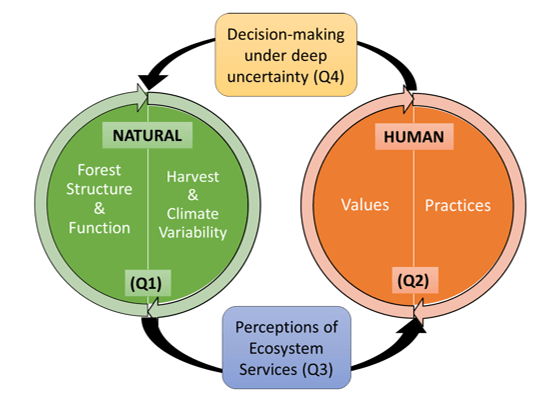How biodiversity and human values shape decision making under climate change
Sustainable forest management under climate change requires a new approach that links human values, projections, and visualization to decision-making under uncertainty.
We plan to link traditional knowledge (TK) with cutting-edge modeling and visualization techniques– including immersive virtual reality (iVR) experiences- to better understand human values and forests and to explore how forest management decisions can be made more robust under deep uncertainty.
Our research explores coupled-human and natural systems
Four questions guide our inquiry:
- How are landscape patterns of forest disturbances and ecosystem services (e.g., biodiversity and carbon storage) shaped by variability in future climate conditions?
- What are the human values and customary practices that influence preferences in sustainable forest structure and function and how do they differ among members of the community?
- How do climate-driven changes in forest species composition, productivity, and disturbance dynamics influence human perceptions of forest condition?
- How do changes in forest management influence future landscape structure and function?

Conceptual framework for the coupled human and natural systems questions that guide our inquiry.
Our primary location

Menominee Nation forest lands in Wisconsin
Our research is located in north-central Wisconsin, centered around the tribal lands of the Menominee Nation, for three main reasons:
- Climate sensitivity: This region represents a climatically sensitive region that is already experiencing climate change impacts that are reducing forest health and complicating management decisions. Model projections suggest that increasing temperatures will cause declines in many important tree species in the northern lake states under current management practices and projected expansions of exotic species (e.g. emerald ash borer) will present numerous management challenges.
- Tribal engagement: Tribal interests are a component of the National Climate Assessment and many tribal groups, including the Menominee, are actively engaged in developing climate adaptation plans or acquiring resources to prioritize adaptation activities.
- Menominee worldview: The sustainability principles of the Menominee Nation reflect central components of the Menominee worldview and provide an opportunity to explore how interactions between values, knowledge, and behaviors can inform ecological modeling and immersive experiences in ways that lead to improved decision-making support.
Our research has four facets
- Social/economic values,
- Climate change science,
- Visualization, and
- Decision-making,
which we hope will lead to a greater understanding of sustainable forest management, as illustrated by the workflow diagram shown below.
Customary practices that inform values (dynamics of human systems) influence pathways of forest change modeled by LANDIS-II (dynamics of natural systems). Through representation of these changes through stand and landscape iVR experiences and interactive visualizations we will assess how people perceive these changes (natural systems influence human systems) and then how these modeled futures influence tradeoffs among values under deep uncertainty, which ultimately affect decision making about forest management (how human systems influence natural systems).

